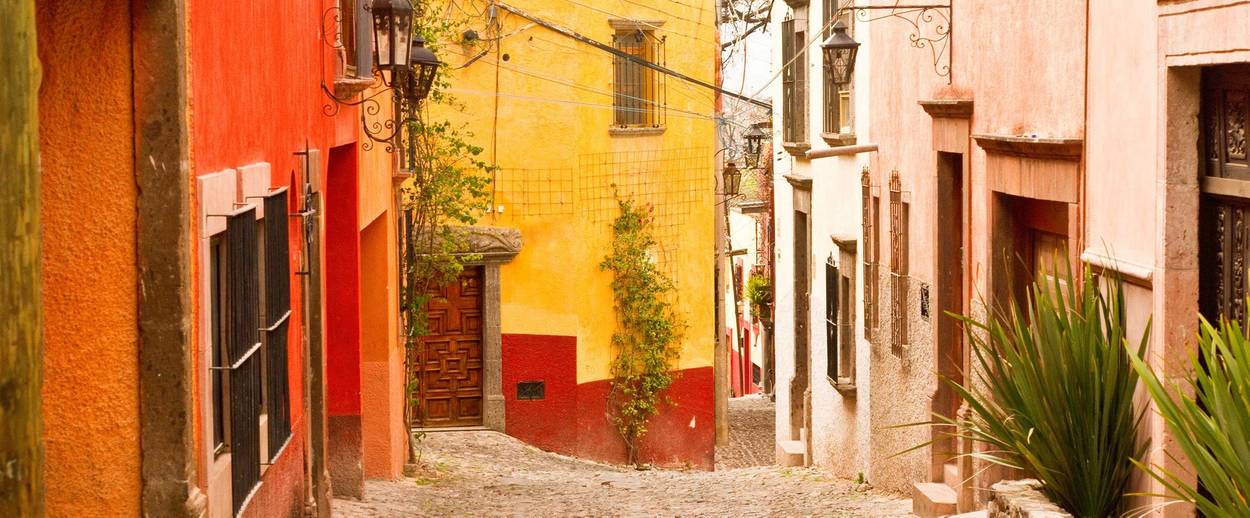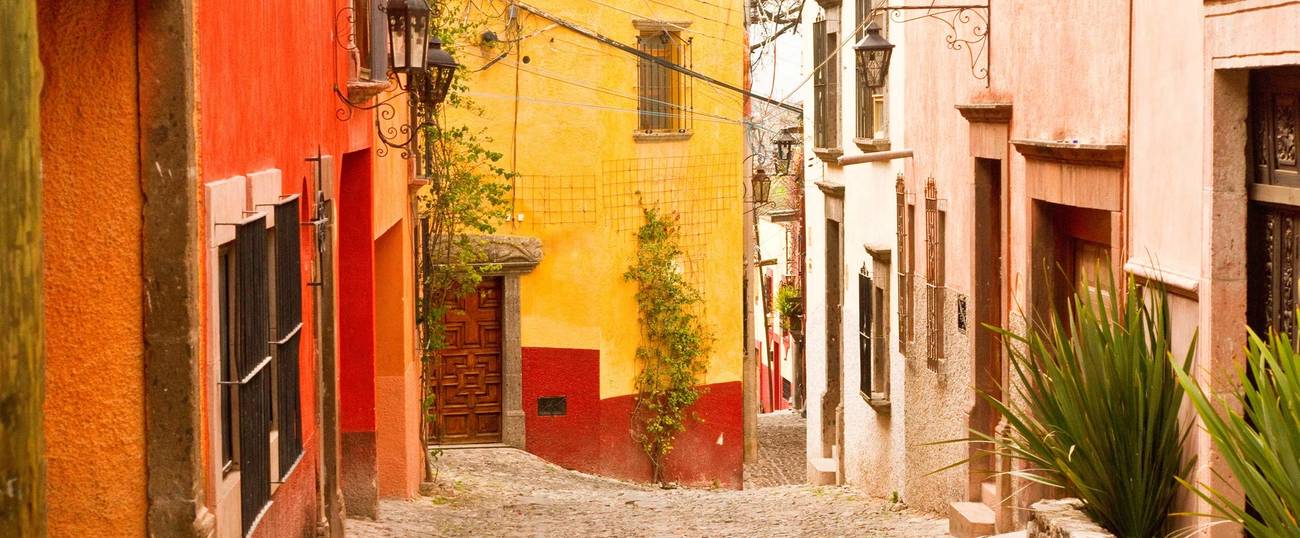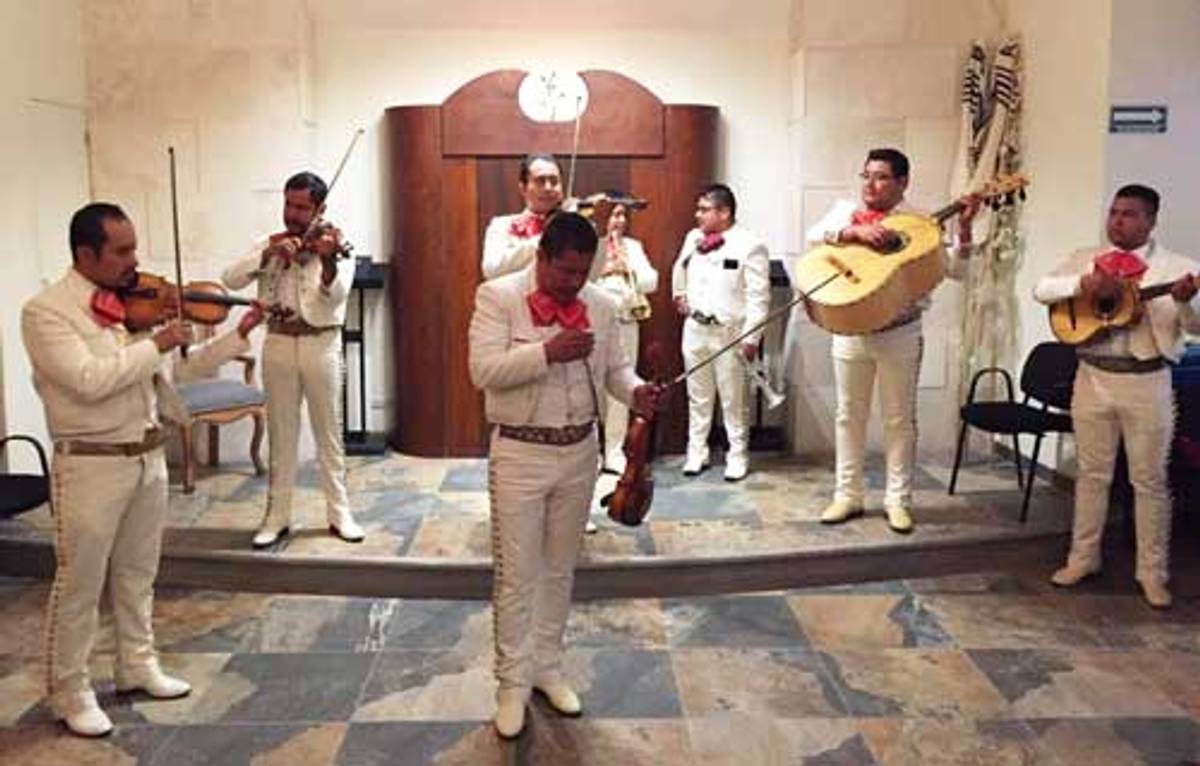The Jews of San Miguel de Allende
As a community of North American expats has expanded in Mexico, dozens of local converts have joined their ranks




As the third aliyah, a woman, ascended the bimah on a recent Saturday morning for the weekly Conservative service at the Jewish Cultural and Community Center (known by the English acronym JC3) in San Miguel de Allende, Mexico, I reached for the only spiral-bound siddur left, one with a Spanish translation, and slipped into a seat in the former warehouse building, now renovated into a synagogue that is home to 198 members. The service was electrifying, conducted in Hebrew, with some readings in English and Spanish, and enthusiastic communal singing.
JC3 is the building that houses CHESMA AC—the Comunidad Hebrea en San Miguel de Allende, Asociacion Civil—which is an inter/nondenominational Jewish community representing some 1,000 Jews (the vast majority of them expats from the U.S. and Canada) living part- and full-time in San Miguel, more than 150 miles northwest of Mexico City. There are a number of groups under CHESMA’s umbrella, including a Reconstructionist/Reform group that gathers for a monthly musical Friday night service, a Reform group that holds a monthly Kabbalat Shabbat service, and the Conservative congregation Kehilah Shalom San Miguel, whose service I attended. CHESMA also sponsors numerous cultural events.
Leading the Conservative service was Dr. Dan Lessner, a pediatrician who retired from his practice in Sag Harbor, New York, at the age of 48 to move to San Miguel in 2005. The current congregation was established in 2007, when Lessner brought a sefer Torah so that there could be an official Torah service instead of a mere Torah discussion group. He became the group’s ritual adviser and president.
Along with several other expats, including Carole Stone from Pittsburgh, Lessner has helped grow the congregation. Initially, members met at a local hotel, where their numbers increased steadily from 30 to 50 or 60—American and Canadian expats who’d retired or relocated to Mexico.
Then, something dramatic happened: Mexicans showed up. First, it was one fellow from nearby Queretaro. Later, it was Mexicans who failed to get the answers they wanted from the Catholic church and became interested in Judaism—only a minority of whom believed that they had Jewish blood. With the help of Rabbi Juan Mejia, himself a convert from Colombia, Lessner began offering comprehensive conversion classes, in person and online, graduating the first group of six students in 2011.
Since then, nearly 70 people have graduated from the congregation’s conversion classes. This March alone, 24 converts graduated—twice as many as any previous year’s cohort—and a recent convert is now leading the congregation.
What began a dozen years ago as a collection of a few dozen expats has changed into something very different. Not everyone is happy with the changes at the congregation, however, and some worry that the once tight-knit community in San Miguel will splinter in the coming years.
Mejia’s day job is as the head of a Hebrew school in Oklahoma, but he considers his pro bono work with converts as his “rabbinic mission.” Raised in Bogota and educated at the Conservative Yeshiva in Jerusalem and the Jewish Theological Seminary in New York, he believes that his work with “emerging communities,” a phrase that he says he coined, is the future for Jews in Latin America. “We must move away from the crypto-Jewish narrative,” one that can be noxious, with Jews comparing who suffered the most. “Genetics,” he said, “should not be an entry ticket to Judaism.”
Mejia has set a high bar for San Miguel’s conversion program, meeting all potential converts face-to-face before they are admitted, and requiring them to participate in hundreds of hours of video and live classes for two years. Although he has worked in several communities including Chavurat Shirat Hayyam in Santa Marta, Colombia, and Chavurat Naariyah in Barranquilla, Colombia, San Miguel has been different because he said that there is a core of learned leadership there. “It’s a truly visionary community,” he said, where congregants say, “All you need is love. You can pray with us.”
One basic rule for the conversion classes is not to convert people from outside of the Central Plains of Mexico. “They have to be members,” Lessner said, of the Conservative congregation.

Lessner resigned from the CHESMA presidency last November, having successfully worked to get the minyan accepted as a member of the United Synagogue of Conservative Judaism, the major congregational organization of Conservative Judaism in North America. He’s proud of what he accomplished although he speaks of finding a balance, with language as a problem. He tried leading a bilingual Torah study group but found that it took too long and was burdensome for the majority of the Mexicans, as well as many of the expats. However, there was also some opposition to splitting into two groups, from “one Mexican (who spoke English) and several Americans who were concerned that the community would be ‘segregated’ if we had two groups.”
“One size definitely did not fit all,” Lessner said. “It was like herding cats.” Today, there are two separate Torah study classes, in English and Spanish, with some Mexicans who speak English attending the English group, and some Americans attending the Spanish group. Although Lessner continues to teach the Torah class in Spanish and to help run the Saturday service, he has turned over the administrative reins to the former vice president, Daniel Torres, who converted to Judaism just two years ago.
“I have no background in Judaism,” Torres said, relating the narrative behind his own conversion. A student of psychology and Freud, Torres was taken with the text of Moses and monotheism and deeply influenced by psychoanalysis and the structure of Judaism. Torres, who was born Catholic in Moroleón, a city in Guanajuato state, moved to Queretaro to attend university. When he found work as a clinical psychologist in the local SMA public health services system, he joined the synagogue. He was interviewed by both Mejia and Lessner. “There were rules,” he said. “We were given text and we had meetings online. We had to be an active member of a Jewish community and the men all had to be circumcised.” In Judaism, Torres found “more than he expected.”
“Judaism provides me with a reference for life,” Torres said.
As the first convert to become president, Torres, 33, who will be up for election in 2020, said, “I feel fully accepted by the community. There have been no negative comments.”
But some congregants voiced concerns over the recent growth of the conversion classes.
I met with Zajar Campos Torres, an active member of the congregation, in the courtyard of the Hotel Monteverde, Best Inn, where he is the owner of a kosher restaurant. (The hotel itself is owned by Soli Cohen, a chazzan and a Sephardic Jew from Turkey who settled in Mexico some 50 years ago and was an early supporter of the congregation.) Born Jewish in Mexico City, Campos Torres taught for 12 years at a culinary arts school in Tijuana, then spent two years at the Paul Bocuse Institute in Guatemala City, ultimately owning a bakery in the country. However, when troubles ensued, he made the decision to return home to Mexico.
Zajar Campos Torres is best friends with the new president, Daniel Torres (no relation), but he is wrestling with what it means to be Jewish. Although he agrees with the conversion process, he has his concerns about whether it has become too lax in recent years. “In the past, conversions like that of Daniel Torres, were very thorough,” he said. “But today more than 90% of the converts don’t know the brachas.” Campos Torres has been doing his own research on the subject of converts. “I visited one house and I saw big crosses and pictures of Jesus on the walls. They told me that those are just decorations. They don’t matter.” Yet, on their cars, he saw stickers for Israel. “The two things just do not match for me,” he said.
Beyond the issue of the converts, Campos Torres feels that the city’s Jewish community is becoming more divided. “The real Conservative Jews are not comfortable with women on the bimah,” he said. With an influx of Jews moving from Mexico City and with the arrival in town last year of Daniel Huebner, an Orthodox Chabad rabbi who has opened Chabad House in its own building, the bubble “that is [San Miguel de Allende] may be bursting,” implying that new conflicts between the more and the less observant might arrive, with some more observant congregants decamping to Chabad.
Judith Cohen, Soli’s wife, stopped by our table to add her thoughts on CHESMA’s future. She was the first person to identify herself and her group as “Jewish Jewish.” She describes San Miguel as a mixed, diverse crowd that always had differences. “It was an expat town full of Jewish people, born of parents affected by the Holocaust but some who were also taught/raised Orthodox and lapsed while others just played Judaism down. The real question people are asking now is how can this young convert lead us all forward?”
The future was very much on the mind of the graduates of this year’s conversion class who participated in the March 14-15 Beit Din ceremony, Mejia’s final conversion in San Miguel. Musician Mario Adrian Moya Acosta, age 28 and a native of San Miguel, was the only one in his family making the conversion, although friends and family have been supportive. Born Catholic, Acosta was deeply influenced by his mother, who belonged to Camino Neocatecumenal, a movement that emphasizes the dynamic of the first Christian communities. According to Acosta, “the Shema was also part of their foundation, among other practices in common with Judaism.”
At first, studying Judaism grabbed Acosta by the intellect. Over time, though, the process disappeared and there was simply a great joy in learning: “I found beauty in its writings, intelligence in the interpretations, and wisdom in its teachings,” he said. Acosta praised Mejia for his love and dedication to the development of a fair Judaism in which there is room for “everyone who really desires it.” It is a mandate and a mission that Lessner and the Conservative congregation hope to continue as they search for a new rabbi to take Mejia’s place. Mejia has decided to take a break from doing conversions, which he described as almost full-time work, to focus on his day job, his three children, and other responsibilities.
Acosta is optimistic about his future and that of other converts to Judaism although, at present, the JC3 is basically “the only place that does conversions ‘openly’ in Mexico,” he said. “I have met young Jews from different countries and they have no issues with people converting. Even my nonreligious Jewish friends love the idea of me being part of the ‘tribe.’”
Waiting in the wings is Angel S.R. Olague, who discovered the community on Facebook some three months ago. Olague began formally studying Torah this year with Lessner and he hopes to convert in two years. “I have had some issues because of the cultural shock,” he said, “but I’m determined to learn.”
Roslyn Bernstein, an arts and culture reporter, is the author of Illegal Living and Boardwalk Stories and Professor Emerita at Baruch College and the Craig Newmark Graduate School of Journalism at CUNY. Her most recent writing project is a young adult novel set in Jerusalem in 1961 during the Adolf Eichmann trial.